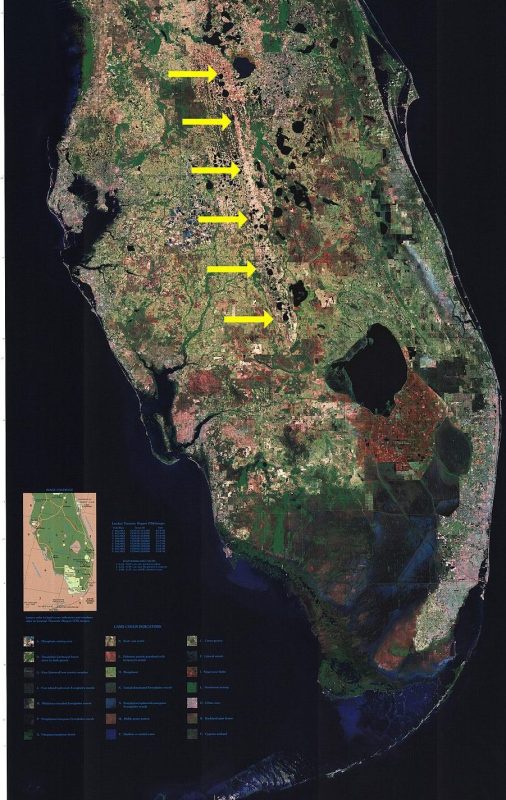Retreat to the Florida Mountains

Last weekend, we visited the Florida “mountains.” Though the high elevations in Florida seem like mere hills compared to real mountains, it’s worth learning about an often-overlooked part of the famous Sunshine State, the high plateau. We stayed in quaint Mount Dora, 184 feet above sea level, or as shown with a bit of humor on the t-shirt above: 2,208 inches.
Of course, the widespread belief is that Florida is flat and about to go underwater, with even modest sea level rise. Readers may recall that two months ago, my blog post “Florida is not going underwater” showed that only a small part of the state would actually go underwater, even with ten feet (3 meters) of sea level rise.
Here I want to put a spotlight on the other end of the elevation spectrum, the large area referred to as the Florida ridge, indicated here by the six yellow arrows. I sometimes describe this as Florida’s spine. Also identified as the Lake Wales Ridge, it runs about 150 miles (~240 km) north-south, roughly from Leesburg at the top arrow to Lake Placid at the bottom. With hundreds of lakes, many refer to it as “the lake district.” In fact, the town of Tevares, next to Mount Dora, identifies itself as America’s seaplane city.

Image: USGS.gov
Three million years ago, when sea level was seventy-five feet higher, those towns were coral islands. In the photo image above, you may notice the light coloration from the white sands, similar to how the Bahamas and other coral-based islands show up in satellite images.
The high point is Sugarloaf Mountain, at 312 feet (95 m) above sea level, in the town of Ferndale, near Clermont. Sugarloaf is the highest point on the Florida peninsula (surpassed slightly by Britton Hill, on the panhandle, near Tallahassee). Sugarloaf would be high and dry even if Greenland and Antarctica eventually had a full meltdown causing seas to rise 212 feet. (That will take many centuries, if not millennia, even at our current rate of warming.)
In all the highly populated coastal areas of the state, from Key West to Miami / Ft. Lauderdale, up to Jacksonville and the Gulf coast from Tampa around to Pensacola, even a few feet of higher sea level are an extremely serious issue and require adaptation planning ASAP. Without minimizing the seriousness of that coastal threat, it is important to recognize that many inland areas such as Orlando, Gainesville, and Tallahassee have good safe elevation and are not at all threatened by rising seas.
As people and businesses become more aware of and more concerned about increased coastal flooding, a common response is to consider alternatives to the sunshine state. That might be a little short-sighted. Higher elevation parts of the state may not only retain their value, they may increase as more people consider the vulnerability of where they live. In other words, those high elevation Florida towns are alternative places to vacation, live, and even to consider for investment.
The important point is that sea level rise will not affect places equally. We have to evaluate locations rather than paint with a broad brush. Some places may be much more vulnerable that you assume, and others less. If you are considering where to live – or to invest in real estate – evaluate the specific location. In the era of rising seas, elevation can be the most important aspect of location.
